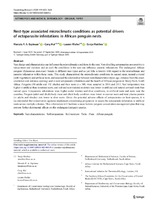| dc.contributor.author | Waller, Lauren J. | |
| dc.contributor.author | Espinaze, Marcela P.A. | |
| dc.contributor.author | Hui, Cang | |
| dc.date.accessioned | 2021-01-05T08:42:57Z | |
| dc.date.available | 2021-01-05T08:42:57Z | |
| dc.date.issued | 2020 | |
| dc.identifier.citation | Waller, L. J. et al. (2020). Nest-type associated microclimatic conditions as potential drivers of ectoparasite infestations in African penguin nests. Physical Therapy in Sport 46, 113-119. | en_US |
| dc.identifier.issn | 1432-1955 | |
| dc.identifier.uri | 10.1007/s00436-020-06895-x | |
| dc.identifier.uri | http://hdl.handle.net/10566/5548 | |
| dc.description.abstract | Nest design and characteristics can influence the microclimatic conditions in the nest. Nest-dwelling ectoparasites are sensitive to temperature and moisture and as such the conditions in the nest can influence parasite infestations. The endangered African penguin (Spheniscus demersus) breeds in different nest types and as yet little is known with regard to the microclimate and parasite infestation within these nests. This study characterized the microclimatic conditions in natural open, natural covered (with vegetation) and artificial nests, and assessed the relationship between nest characteristics (type, age, distance from the coast, orientation and entrance opening) and in-nest ectoparasite infestations and the health of African penguins in Stony Point, South Africa. Penguins (50 adults and 192 chicks) and their nests (n = 308) were sampled in 2016 and 2017. | en_US |
| dc.language.iso | en | en_US |
| dc.publisher | Springer Nature | en_US |
| dc.subject | African penguin | en_US |
| dc.subject | Fleas | en_US |
| dc.subject | Nest characteristics | en_US |
| dc.subject | Soil moisture | en_US |
| dc.subject | Soil temperature | en_US |
| dc.title | Nest-type associated microclimatic conditions as potential drivers of ectoparasite infestations in African penguin nests | en_US |
| dc.type | Article | en_US |

